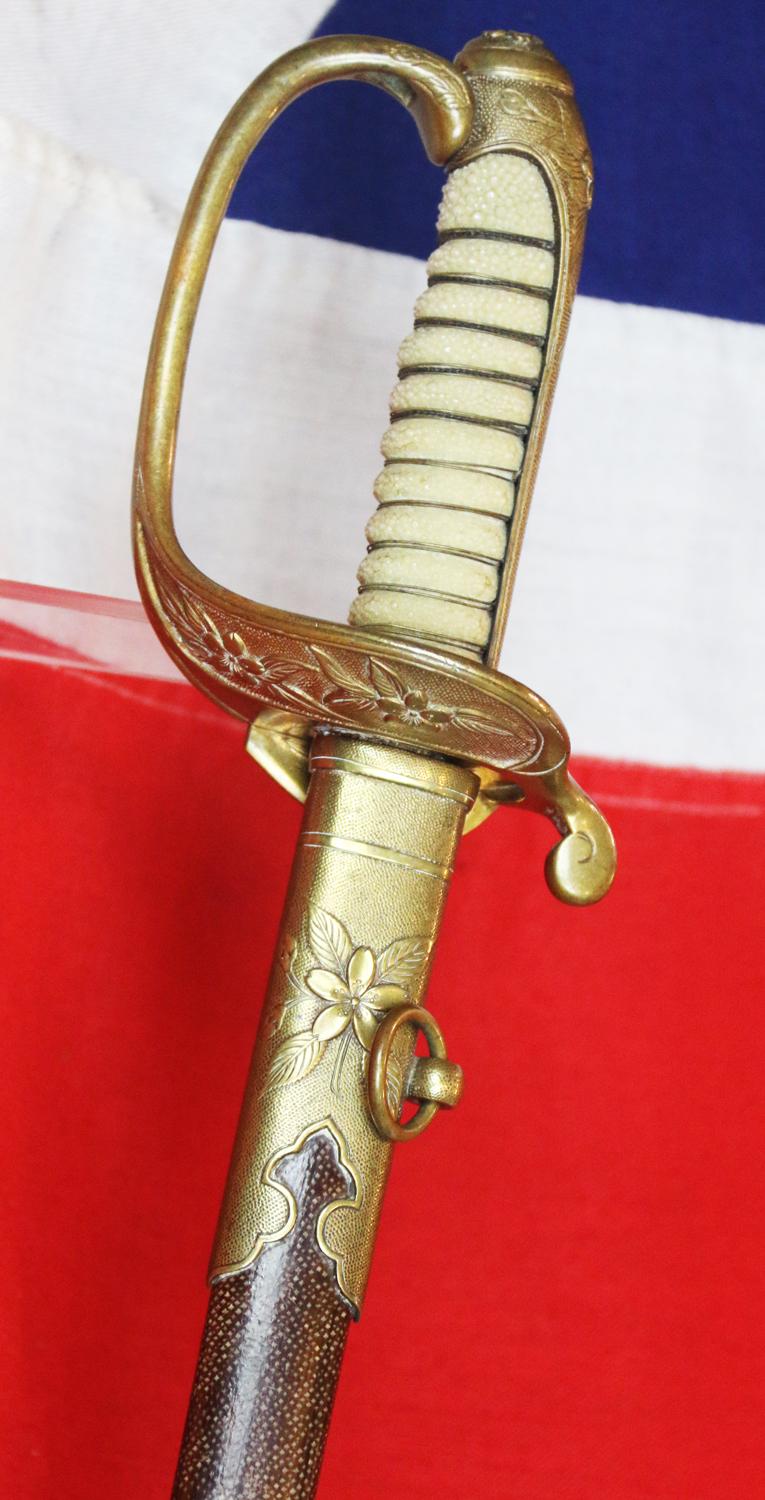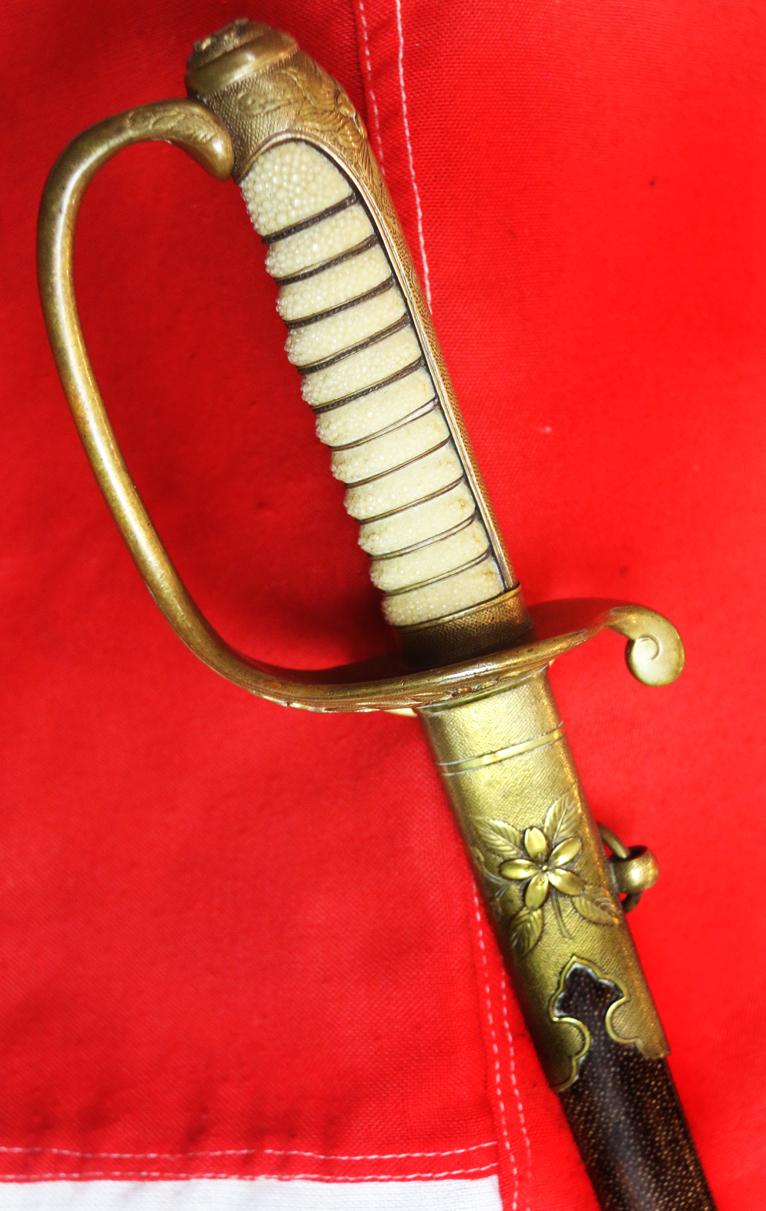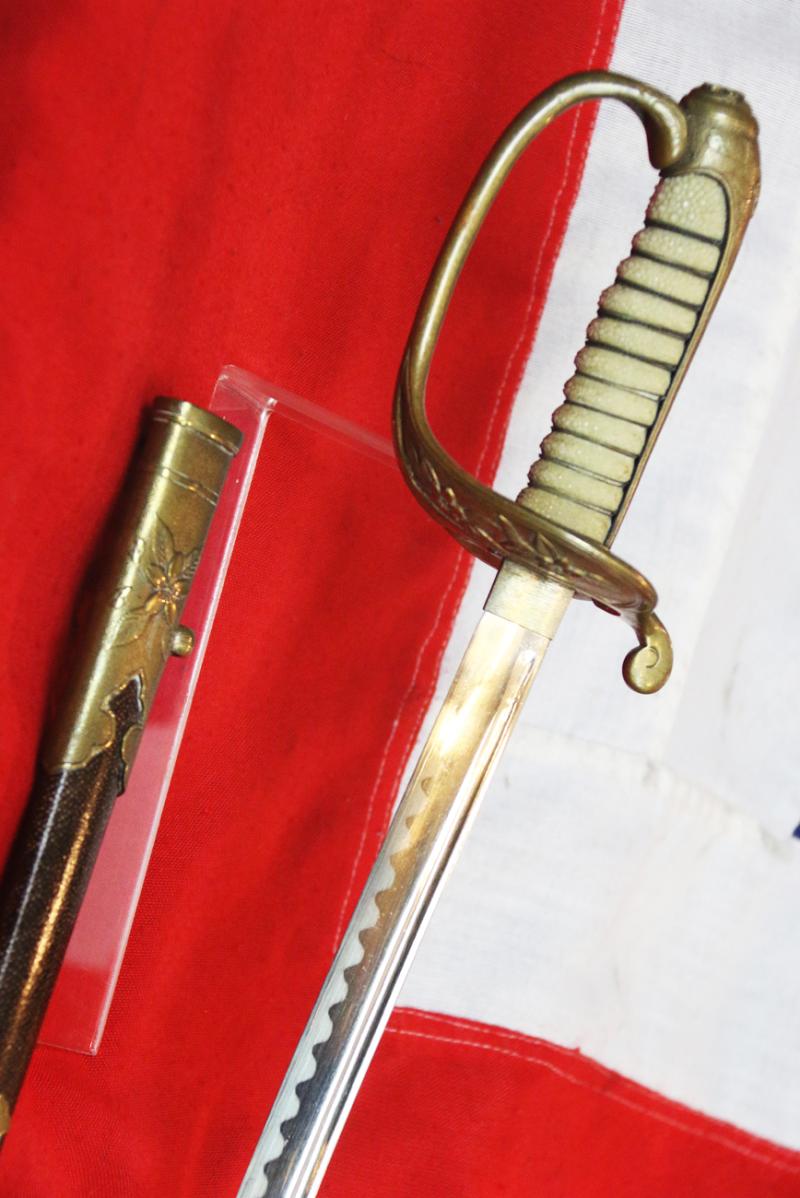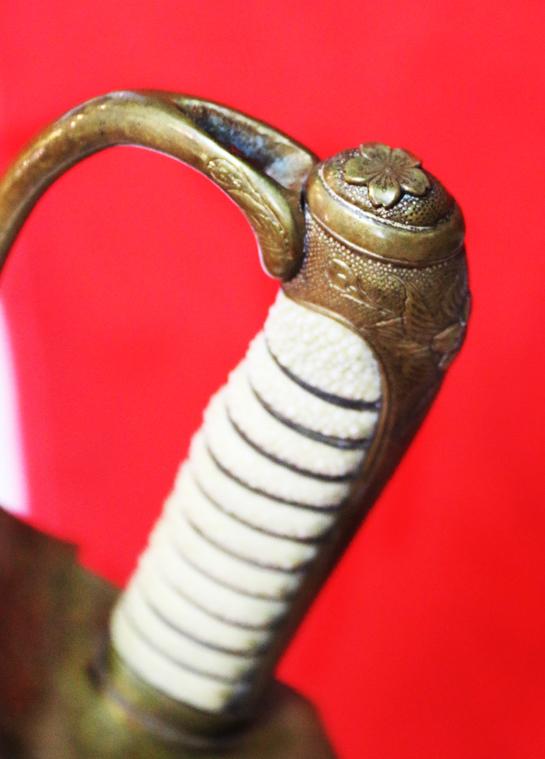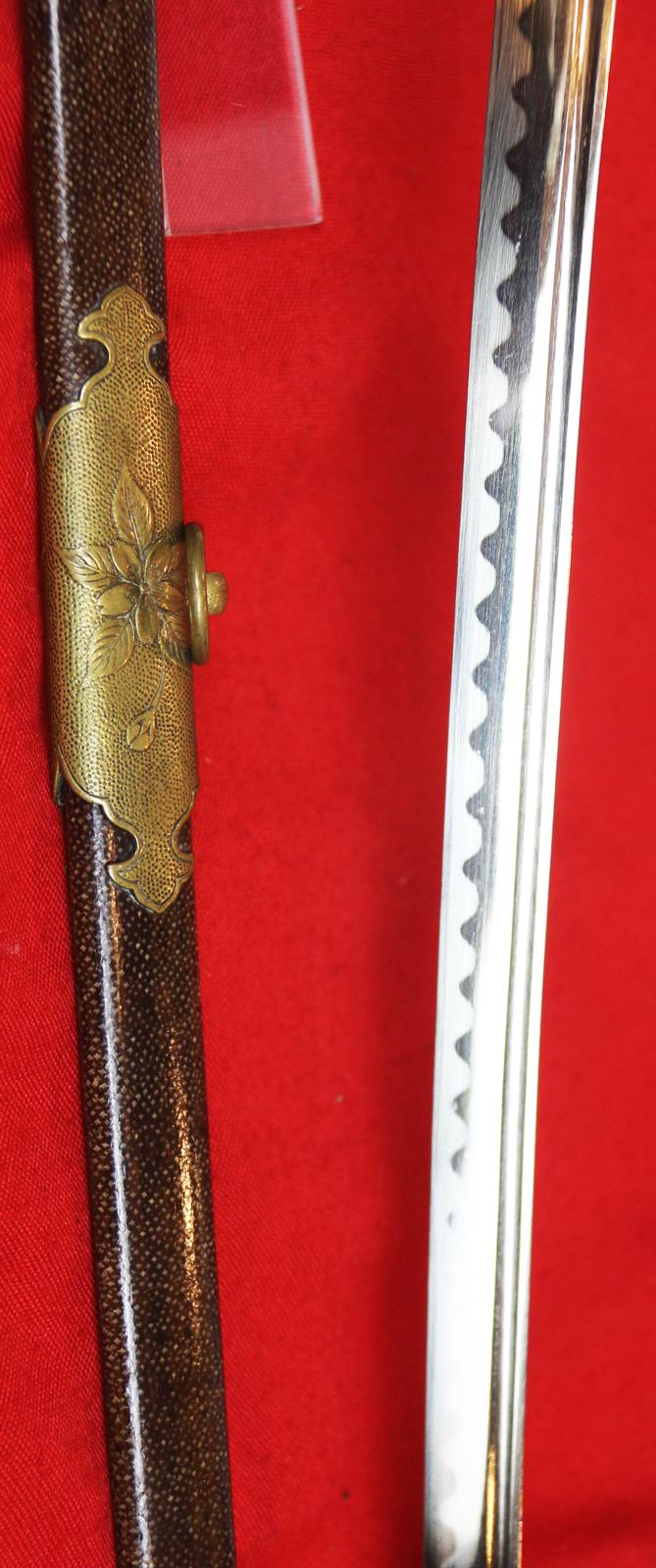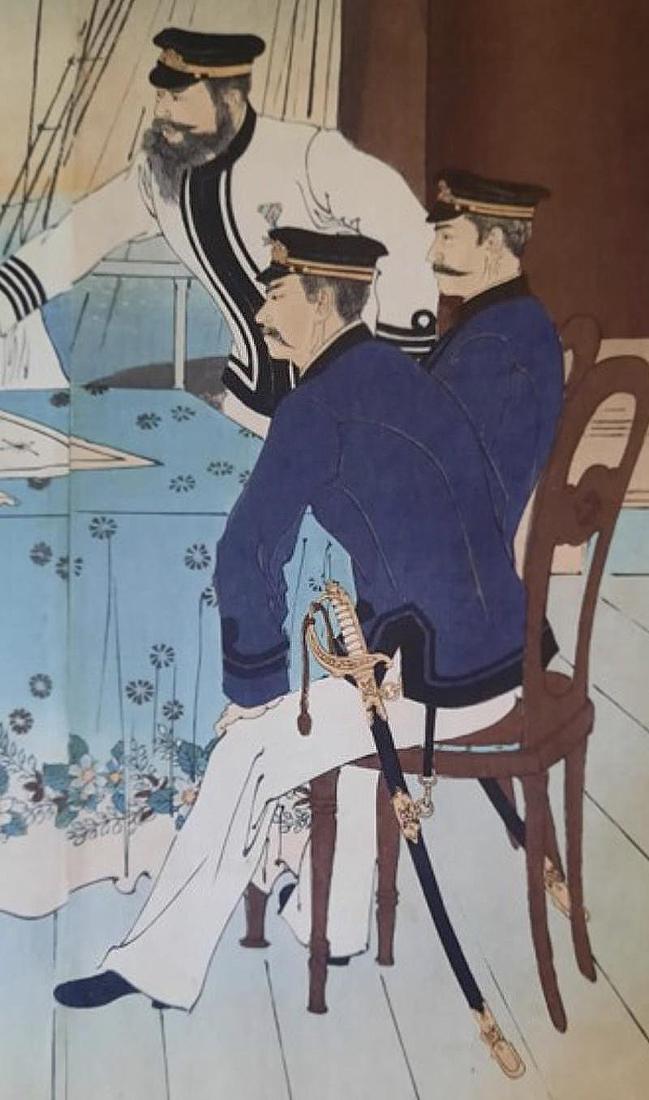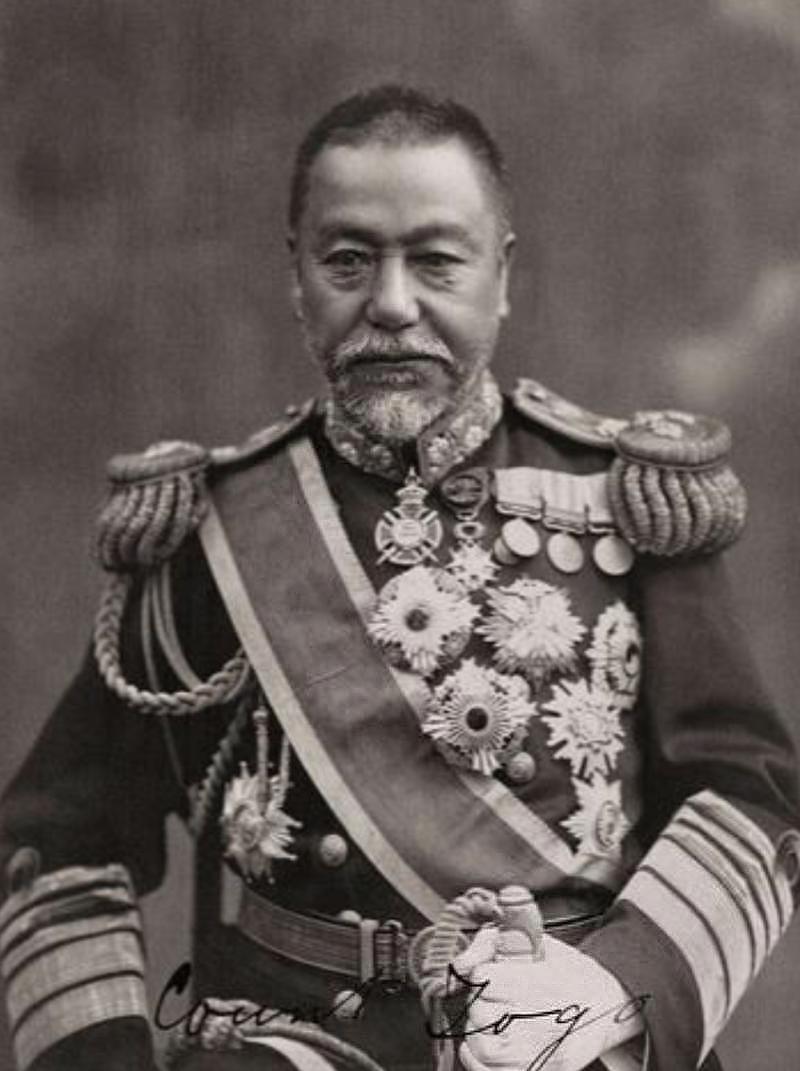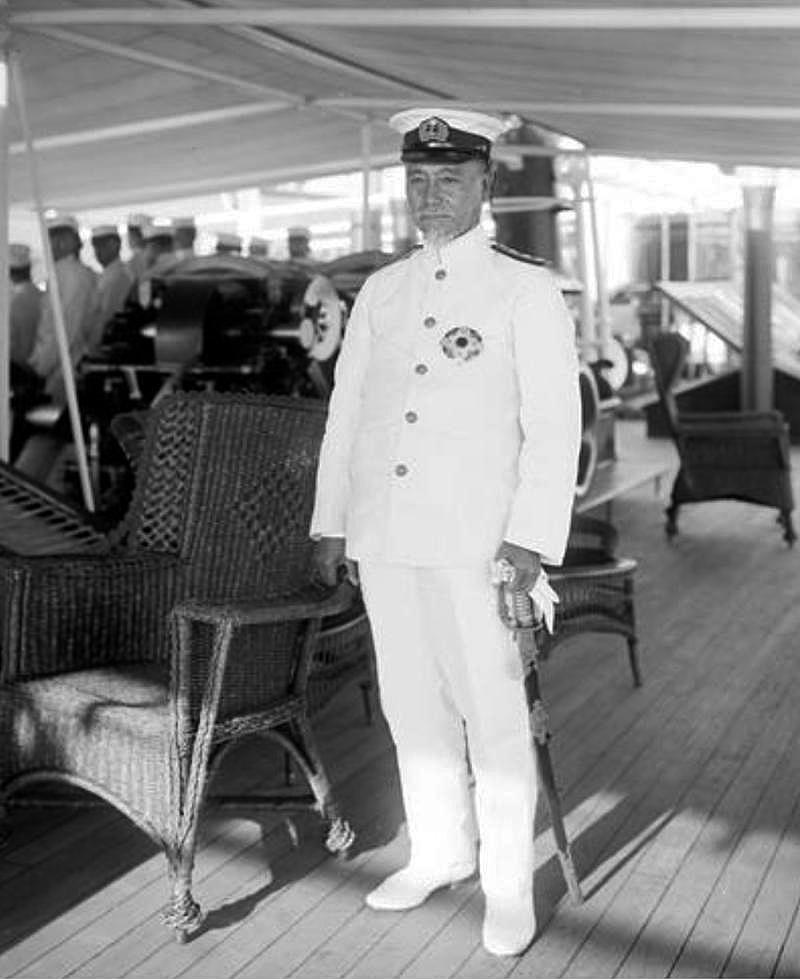A Very Fine & Rare Original Japanese Senior Middle Rank Naval Officer’s 1883 Pattern Kyu-Gunto Sabre Used During Three Of The Most Important Japanese Wars In History, The Russo-Japanese War, WW1 and WW2
This is a beautiful and historically interesting original Japanese sword of maritime service. Especially in WW2, during which, in the IJN, the majority of officers chose to wear in naval service WW2 pattern Kai-gunto sword, based on the old samurai sword pattern used by all three Imperial Japanese armed services from 1936, but some officers of long serving traditional naval families were permitted carry the Western style sword, adopted by the Imperial Navy as its official officer’s sword, in the later 19th century, after the elimination of the whole samurai caste in the Meiji era.
Gilt pierced hilt with folding side guard, wire bound giant rayskin grip and single knuckle bow, gilt and polished samegawa giant rayskin saya. Overall in very nice condition. Regular etched gunome hamon pattern blade, of full length.
As soon as Japan opened up to foreign influences, the Tokugawa shogunate recognized the vulnerability of the country from the sea and initiated an active policy of assimilation and adoption of Western naval technologies.
Russo-Japanese War. At the Battle of Tsushima, Admiral Togo (flag in Mikasa) led the Japanese Grand Fleet into the decisive engagement of the war. The Russian fleet was almost completely annihilated: out of 38 Russian ships, 21 were sunk, seven captured, six disarmed, 4,545 Russian servicemen died and 6,106 were taken prisoner. On the other hand, the Japanese only lost 116 men and three torpedo boats.62 These victories broke Russian strength in East Asia, and triggered waves of mutinies in the Russian Navy at Sevastopol, Vladivostok and Kronstadt, peaking in June with the Potemkin uprising, thereby contributing to the Russian Revolution of 1905. The victory at Tsushima elevated the stature of the navy.
The new fleet consisted of:58
6 battleships (all British-built)
8 armored cruisers (4 British-, 2 Italian-, 1 German-built Yakumo, and 1 French-built Azuma)
9 cruisers (5 Japanese, 2 British and 2 US-built)
24 destroyers (16 British- and 8 Japanese-built)
63 torpedo boats (26 German-, 10 British-, 17 French-, and 10 Japanese-built)
Japan entered World War I on the side of the Entente, against Germany and Austria-Hungary, as a consequence of the 1902 Anglo-Japanese Alliance. In the Siege of Tsingtao, the Imperial Japanese Navy helped seize the German colony at Jiaozhou Bay. During the siege, beginning on 5 September 1914, Wakamiya conducted the world's first successful sea-launched air strikes. On 6 September 1914, in the very first air-sea battle in history, a Farman aircraft launched by Wakamiya attacked the Austro-Hungarian cruiser Kaiserin Elisabeth and the German gunboat Jaguar off Qingdao.72 from Jiaozhou Bay. Four Maurice Farman seaplanes bombarded German land targets like communication and command centers, and damaged a German minelayer in the Tsingtao peninsula from September to 6 November 1914 when the Germans surrendered.
A battle group was also sent to the central Pacific in August and September to pursue the German East Asia squadron, which then moved into the Southern Atlantic, where it encountered British naval forces and was destroyed at the Falkland Islands. Japan also seized German possessions in northern Micronesia, which remained Japanese colonies until the end of World War II, under the League of Nations' South Seas Mandate.74 Hard pressed in Europe, where she had only a narrow margin of superiority against Germany, Britain had requested, but was denied, the loan of Japan's four newly built Kongō-class battlecruisers (Kongō, Hiei, Haruna, and Kirishima), some of the first ships in the world to be equipped with 356 mm (14 in) guns, and the most formidable battlecruisers in the world at the time.75
Following a further request by the British and the initiation of unrestricted submarine warfare by Germany, in March 1917, the Japanese sent a special force to the Mediterranean. This force, consisted of one protected cruiser, Akashi as flotilla leader and eight of the Navy's newest Kaba-class destroyers (Ume, Kusunoki, Kaede, Katsura, Kashiwa, Matsu, Sugi, and Sakaki), under Admiral Satō Kōzō, was based in Malta and efficiently protected allied shipping between Marseille, Taranto, and ports in Egypt until the end of the War.76 In June, Akashi was replaced by Izumo, and four more destroyers were added (Kashi, Hinoki, Momo, and Yanagi). They were later joined by the cruiser Nisshin. By the end of the war, the Japanese had escorted 788 allied transports. One destroyer, Sakaki, was torpedoed on 11 June 1917 by a German submarine with the loss of 59 officers and men. A memorial at the Kalkara Naval Cemetery in Malta was dedicated to the 72 Japanese sailors who died in action during the Mediterranean convoy patrols.77
In 1917, Japan exported 12 Arabe-class destroyers to France. In 1918, ships such as Azuma were assigned to convoy escort in the Indian Ocean between Singapore and the Suez Canal as part of Japan's contribution to the war effort under the Anglo-Japanese alliance. After the conflict, the Japanese Navy received seven German submarines as spoils of war, which were brought to Japan and analysed, contributing greatly to the development of the Japanese submarine industry.
Imperial Japanese Navy in World War II
The IJN launched a surprise attack on Pearl Harbor, killing 2,403 Americans and crippling the US Pacific Fleet. During the first six months of the Pacific War, the IJN enjoyed spectacular success inflicting heavy defeats on Allied forces. Allied navies were devastated during the Japanese conquest of Southeast Asia. Japanese naval aircraft were also responsible for the sinkings of HMS Prince of Wales and HMS Repulse which was the first time that capital ships were sunk by aerial attack while underway. In April 1942, the Indian Ocean raid drove the Royal Navy from South East Asia.
In 1943, the Japanese also turned their attention to the defensive perimeters of their previous conquests. Forces on Japanese held islands in Micronesia were to absorb and wear down an expected American counteroffensive. However, American industrial power become apparent and the military forces that faced the Japanese in 1943 were overwhelming in firepower and equipment. From the end of 1943 to 1944 Japan's defensive perimeter failed to hold.
The defeat at the Philippine Sea was a disaster for Japanese naval air power with American pilots terming the slanted air/sea battle the Great Marianas Turkey Shoot, mostly going in the favour of the US,126 while the battle of Leyte Gulf led to the destruction of a large part of the surface fleet. During the last phase of the war, the Imperial Japanese Navy resorted to a series of desperate measures, including a variety of Special Attack Units which were popularly called kamikaze. By May 1945, most of the Imperial Japanese Navy had been sunk and the remnants had taken refuge in Japan's harbours. By July 1945, Nagato was the only remaining ship of the Imperial Japanese Navy's capital ships that had not been sunk in raids by the United States Navy
Every single item from The Lanes Armoury is accompanied by our unique Certificate of Authenticity. Part of our continued dedication to maintain the standards forged by us over the past 100 years of our family’s trading, as Britain’s oldest established, and favourite, armoury and gallery
Code: 24988


